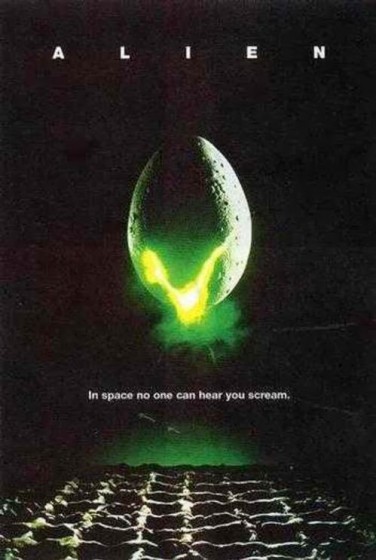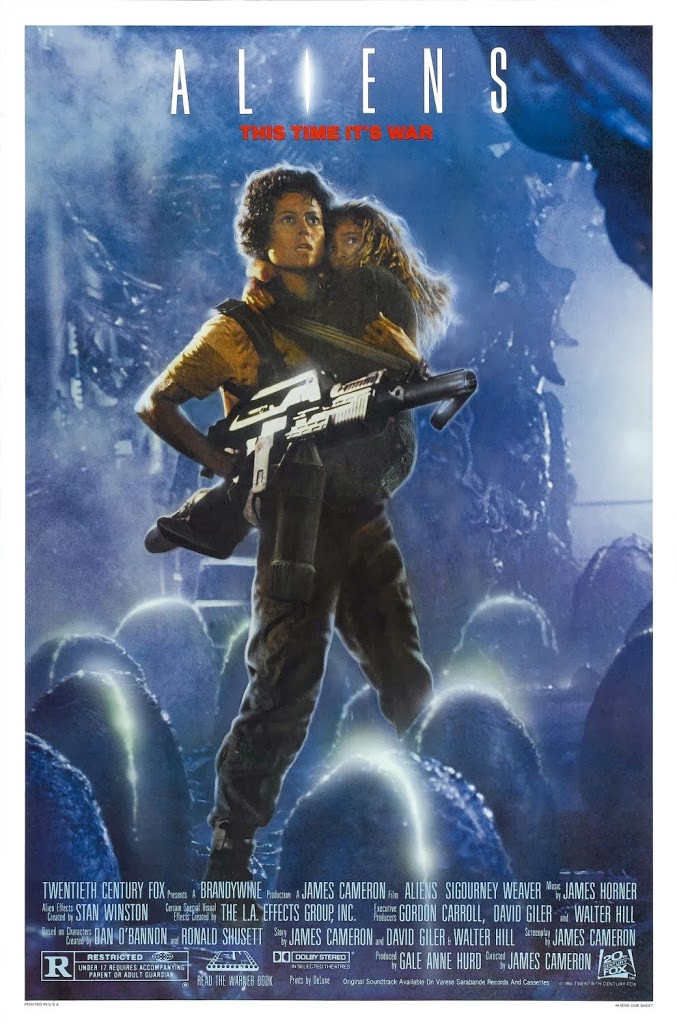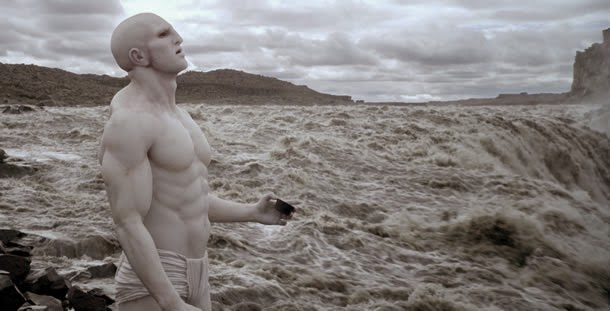Directed by Ridley Scott | Written by Dan O’Bannon and Ronald Shusett | 117 min | Crave Plus
Alien has been around so long it’s kind of hard to imagine the world without those cute lil’ exomorphs that kinda look like stainless steel dildos with teeth. When I was a kid I remember the excitement around the 1979 film—people saying it was the scariest movie since The Exorcist. I hadn’t seen that at the time but I knew it was supposed to be super-scary. And that tag-line, “In space no one can hear you scream.” It’s still creepy.
I now know the four Alien movies (and even Prometheus) too well to be afraid at all, but watching the original again, I’m reminded that Ridley Scott’s gift for tone and visuals seems to have been fully formed in his earliest work. And it wasn’t just the director who was firing on all cylinders: the production design and art direction (by Michael Seymour, Roger Christian and Les Dilley) are almost as iconic and influential as what we saw in Scott’s Blade Runner. The Jerry Goldsmith score sets just the right creepy tone, perfect for what has been described as a “haunted house in space” movie. And the casting, a combination of veteran Brit and American actors, with newcomer Sigourney Weaver as Lt. Ellen Ripley, is perfect. These days terms such as “LV-426” and “the Facehugger” actually have cultural significance. Well, at least they do to me.
The story is fairly straightforward: the human crew (Tom Skerritt, John Hurt, Ian Holm, Yaphet Kotto, Harry Dean Stanton, Veronica Cartwright and Weaver), along with an orange cat named Jones, of the space tug Nostromo, is brought out of cryogenic sleep in the middle of nowhere (galactically speaking) when the ship’s computer detects a repeating signal of unknown origin. They set down on some god-forsaken rock and find a derelict spaceship. Inside is a fossilized alien pilot and a chamber full of enormous, tumescent eggs. One of the eggs hatches and a thing attaches itself to the face of one of the crew. And, later, a highly aggressive alien gets into the Nostromo. Though you should expect some mild spoilers throughout this series review, I’ll just pause here to say: very bad things happen.
The film has been psychoanalyzed to death. I don’t know if it’s really about the fear of pregnancy, but I do know H.R. Giger‘s alien designs have real Freudian weirdness. I also recognize one of the great things about the film are how issues of class found their way into a mainstream science fiction movie for the first time. (Screenwriter O’Bannon, who also worked on Dark Star, is to be credited, I believe.)
Parker (Kotto) and Brett (Stanton), basically below-deck workers, described as “Truckers In Space”, rail against management representatives on the inequity of wages and how The Company—in sequels known as Weyland-Yutani—is screwing the little guy. And then there’s the corporate conspiracy—carried out by the Nostromo’s computer Mother and the science officer Ash (Ian Holm)—to protect the alien and ensure it returned to The Company’s bioweapon division.
The pleasure of revisiting the film on Blu-Ray is very much like seeing Blade Runner‘s Final Cut on the high-definition format. Everything is lighter and more distinct. The care that went into those Nostromo corridors, the bridge, the shuttlecraft, the medical bay, has never been more obvious and impressive. The tech, made to look as if it had been retrofitted, still looks great. Yes, it’s the future as seen from the 1970s—keyboards are ancient, digital readouts are green and boxy—but it has a wonderful, timeless quality to it, too. Old, dusty machines always look cool.
Aliens (1986)
Directed by James Cameron | Written by Cameron, David Giler, and Walter Hill, from characters created by O’Bannon and Shusett | 137 min | Crave Plus
I wish I could say that Blu-Ray is a good technology for Aliens from 1986, James Cameron’s everything-is-bigger sequel.
Of the film itself, I’ve long thought of it as one of the best follow-ups in Hollywood history. It deftly avoids any accusation of repetition by going much wider on all fronts. Instead of a single alien hunting a crew of seven, we have a host of those reptilian/insectoid things in an industrial complex, facing off against a well-armed battalion of space marines. The care to sets in the first film has been applied here to props: I can’t think of another feature where weaponry is so fetishized. Instead of the film being a slow, suspenseful horror, we get an adrenalized action movie, slow to start but providing exponential thrills as we go along.
One of the really amazing things is how we get time to know and care for the characters. Cameron allows us to hang with many of the marines sent to LV-426—we are decades into the future from the last film, and the foggy planetoid had been colonized by terraformers. The soldiers are sent on a rescue mission when LV-426 drops out of contact with earth.
The deliberate set-up gives us time to care about these rescuers and feel for them as they rush in to face what we well know to be hard-to-kill nasties. Gorman (William Hope), Vasquez (Jenette Goldstein), Hicks (Michael Biehn), Apone (Al Matthews), Drake (Mark Rolston) and especially Hudson (the hilarious Bill Paxton) all register solidly. Even Bishop (Lance Henrikson), the soft-spoken android, we feel some sympathy for when Ripley’s synthetic-life bigotry manifests in the Sulaco’s cafeteria.
We also get to know one of the most obnoxious characters in cinema history: Burke, played by the forever weaselly Paul Reiser. As a representative of Weyland-Yutani, Reiser quickly reveals himself to be total scum. As Ripley remarks, maybe we humans are actually worse than the aliens: “You don’t see them fucking each other over for a percentage.”
And a big part of this movie is Ripley discovering—or rediscovering, if you’ve seen the Special Edition of the film—her maternal instinct by protecting the tween Newt (Carrie Henn), the last colonial survivor. The emotional honesty provides a great foundation for all the action set-pieces, right up to the final showdown between the Alien Queen and a very well-armed former Warrant Officer.
But about the Blu-Ray: unlike the earlier movie, the enhanced resolution really reveals the flaws in the the film’s production design. That’s not to say Aliens isn’t an impressive-looking production: it is. But miniatures of spacecraft and ground vehicles, exteriors on LV-426 that were shot in studio, back projections, all that stuff looks more obvious and staged than ever, to the point of distraction.
This is the conundrum with Blu-Ray; it’s very hard to predict when a film will be improved by the technology or whether it’ll reveal weaknesses in the original design. Unfortunately, in the case of Aliens, it’s very much the latter. Accordingly, I’d recommend sticking to the DVD version.
Alien3 (1992)
Directed by David Fincher | Written by Vincent Ward, Giler, Hill, and Larry Ferguson, from characters by O’Bannon and Shusett | 115 min | Crave Plus
Alien3 looks pretty good on Blu-Ray, but it’s not enough to recommend the film as a whole. David Fincher’s venture into the franchise is a stinker and hasn’t aged nearly as well as the first two entries, no matter the HD scrub.
Over the opening credits, two of the hard fought survivors of Aliens, Newt and Hicks, are dispatched from the story. I found this hugely frustrating given the affection I have for those two, built up over the running time of the previous picture. So, instead, here we are with Ripley once again stuck in a bad situation and dealing with the remorseless alien beastie. This time she’s crash-landed on a prison planet populated by a handful of inmates—all men—who’ve found god. Well, most of them (including Withnail & I veterans Paul McGann and Ralph Brown), but there is a roustabout, played by the American in the fold, Charles S. Dutton. Unfortunately, all are cardboard cutout characters, not one with the personality of the space marines in the previous film.
That said, we can see that no one is terribly happy to have a woman show up, even when she shaves her head in solidarity with the boys (or to avoid the terrible lice problem, it’s never really clear). The prison medic, played by Charles Dance, may be the only one charmed by the last survivor of the Nostromo. But you don’t want to get too close to Ripley. She comes with baggage.
Unlike the marines in Aliens, we don’t really care about any of these guys. And the story just kind of loiters without intent. Yes, we know a critter is going to grow and begin killing people—more bloodily than ever—but it’s just not engaging. Ripley, who was the heart of the story in both previous movies, seems like a peripheral character here, burned out and resigned. And when the end comes, the confused religious iconography doesn’t add up to very much. The sets and design is typically fine, but that the only element of quality that really carries over.
Alien Resurrection (1997)
Directed by Jean-Pierre Jeunet | Written by Joss Whedon, from characters by O’Bannon and Shusett | 109 min | Crave Plus
The fourth entry into the franchise doesn’t get much love, but while I understand those who argue it feels a bit like it’s slid into b-movie territory (and how many franchises don’t by the fourth one), it’s so much more playful and surprising than the third film, and Whedon’s clever script paired with Jeunet’s surreality makes for maybe the most fun you’ll have in an Alien movie.
We jump ahead another 200 years from the last picture. Ripley has been cloned by military scientists, once again aboard a space ship out in the inky blackness.
I like the aesthetic continuity between the films here. The industrial nature of these spacecraft never seems to change across the centuries. There’s something comforting about that.
Anyway, these scientists, led by the supremely oily Brad Dourif and J.E. Freeman (playing a variation on his psychopathic gangster from Miller’s Crossing) are very much in line with the old boys at Weyland-Yutani—the corporation they namecheck then sniff at for their corporate, capitalist, so-last-century intent. These guys say they’re cloning Ripley to extract alien DNA for the sake of science and understanding, but the way they gnash their teeth, you know it’s the possibilities of weaponization that really interest them. So little had changed.
The military operation, led by the twitchy Dan Hedaya and his incredibly hairy shoulders—almost as scary as the xenomorphs—is dealing with space pirates. Imagine Whedon’s Firefly with a much less likeable crew, and you’ll get a sense of these guys, including ship captain Michael Wincott and his Mark Lanegan-esque voice, CSI: Crime Scene Investigation veteran Gary Dourdan, Ron Perlman in supreme asshole mode and even a sullen Winona Ryder, who has a secret. They’re delivering stolen cryo-tubes, popsicle people. You know with aliens around it’s going to go badly for these people.
The aliens are more glistening and drooly than ever. But maybe most frightening, most impressive, is Sigourney Weaver. Her Ripley Mark II—known as Number Eight in the film due to earlier efforts—is darker, more hollow than ever. Spliced at a genetic level with this monster, she’s really become one herself. The character is but a shadow of who she was in the previous films, and that’s what makes her special. Her humanity is just out of frame, but for one or two moments, like when she comes face to face with the earlier versions of herself.
And you know what else works? The splicing of Whedon and Jeunet’s wit. I don’t know which one of them came up with the idea of breathing on the doorknob as a security feature, but it killed me. And most of Perlman’s gags hit their targets. The gooey creatures, such a big part of what creeps people out about this series, reach their apex here with a final, more fleshy star beast—it actually didn’t do too much for me, but by then I was very much engaged, so was willing to go where the filmmakers took me.
The Blu-Ray treatment for Alien Resurrection is a slam-dunk, to borrow a basketball metaphor from the film—apparently Weaver became quite a fan of the NBA due to a first-act scene on the court. I remembered the CGI from this film to be pretty shoddy. This where I started to make a case for “a guy in a rubber suit” and creative use of lighting as being far more effective than these computer animations. But, you know what? It’s not that bad. Even the scene that takes place underwater in the flooded kitchen, featuring submersible aliens, was better than I’d remembered. So, either they cleaned it up for Blu-Ray or I’ve seen stuff since that’s been so much worse. I would say Jeunet’s mistake is to show too much of aliens overall. Once they get out of their cages, we see them too clearly too many times, which I believe diminishes the scares.
But, generally, I’d say the fourth film is the one most deserving of reconsideration.
You won’t find my reviews of the two Aliens vs. Predator films. I’ve never heard anything good about them, so haven’t gone there. Maybe one day. But if you’d like to read my detailed thoughts on Prometheus, Ridley Scott’s more recent film set in the Alien universe that really looks marvelous on Blu-Ray, go here and here.










